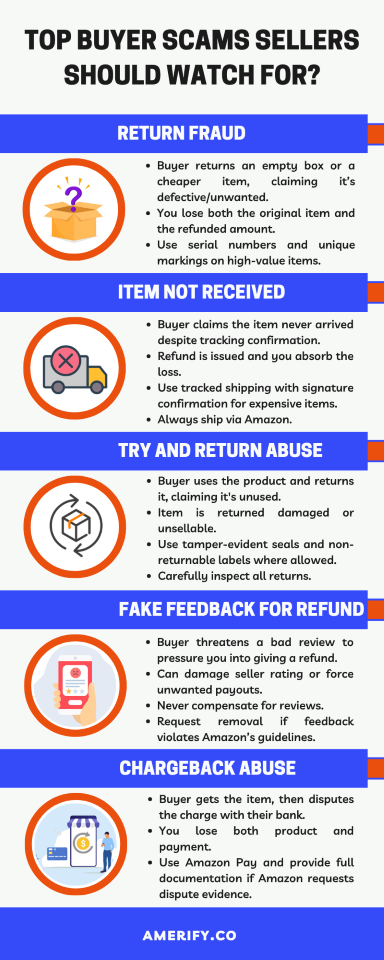Key Takeaways:
- Ten prevalent buyer fraud tactics return fraud, “item not received” (INR) claims, wardrobing abuse, switch fraud, coupon abuse, and false feedback or refund demands—can severely harm sellers by triggering refunds, depositing counterfeit returns, or damaging account health.
- Prevention hinges on proactive safeguards such as using tracked or signature shipping, tamper‑proof packaging, photo/video documentation, Amazon Transparency and Buy Shipping tools, and brand registry—especially critical for high‑value or brand‑registered listings
- Active seller response is essential: inspect all returns carefully, document all transactions, report abusive buyer behavior via Seller Central or branded help channels, and escalate repeat offenders to Amazon—supported by evidence—to mitigate fraud and protect account standing
While Amazon is designed to be a trustworthy marketplace for both buyers and sellers, fraudulent buyer activity is a growing concern — particularly for third-party sellers who bear the cost of abuse.
From return fraud to fake claims and chargeback manipulation, buyer scams can eat into your profits, harm your account health, and even risk suspension if not addressed proactively.
In this guide, we’ll break down the 10 most common buyer scams on Amazon, explain how they work, and share actionable strategies to prevent and protect your business.
Why Buyer Fraud Hurts Sellers the Most?
Amazon’s customer-first policies — while well-intentioned — can leave sellers vulnerable:
- Refunds are often automatic
- Return windows are long and abusable
- Negative feedback from scammers still impacts metrics
- Too many A-to-Z claims or charge backs can trigger account warnings
That’s why prevention is your first — and often only — line of defense.
Top 10 Buyer Scams Sellers Should Watch For?

Choose amerify and experience the difference our experts can make.
1. Return Fraud (Empty Box or Item Switch)
How it works: A buyer orders your product, returns an empty box or a different (cheaper) item, and claims it was defective or unwanted.
Impact: You lose both the product and the refund
How to prevent it?
- Use unique serial numbers or markings for high-value items.
- Take photos of your inventory before shipping (especially for FBM).
- Record weights and dimensions; discrepancies may help in A-to-Z appeals.
- Use Amazon Transparency program if you’re Brand Registered.
2. INR Fraud (Item Not Received)
How it works: Buyer falsely claims the item never arrived, even when tracking shows delivery.
Impact: Refund is issued. Seller bears cost.
How to prevent it:
- Always use tracked shipping with signature confirmation for high-value items.
- Save delivery confirmations from carriers.
- Use Amazon Buy Shipping for A-to-Z protection.
- For repeat offenders, open a case and flag the account internally.
3. Wardrobing (Try-and-Return Abuse)
How it works: The buyer wears or uses the product (e.g., clothing, electronics, tools), then returns it as “unused.”
Impact: Returned product is no longer sellable.
How to prevent it?
- Use tamper-evident packaging or return seals.
- Clearly label hygiene-sensitive or consumable items as non-returnable (if eligible).
- Inspect all returns before restocking.
- Report suspected abuse via Seller Central.
4. “Used Sold as New” Claims
How it works: Buyer falsely claims a new item was previously used, triggering warnings on your account.
Impact: Potential ASIN suspension or even account suspension.
How to prevent it:
- Keep documentation of sourcing (invoices, manufacturer communications).
- Take packaging photos before shipping.
- Avoid sourcing from gray-market or unverified suppliers.
5. Partial Item Swap
How it works: Buyer swaps out a part (e.g., charger, lens, accessory) and returns the rest.
Impact: You receive incomplete inventory and cannot resell.
How to prevent it?
- Use inner sealable packaging or component tracking (e.g., barcodes for parts).
- Take “what’s in the box” photos and use them in your product listings.
- Check weights of returned shipments for discrepancies.
6. “Never Ordered” Scam
How it works: Buyer claims they never placed the order and requests a refund after delivery.
Impact: Possible chargeback and inventory loss.
How to prevent it:
- Use Amazon’s Buy Shipping (ensures you’re covered if you win A-to-Z).
- For FBM, request delivery signature on orders over $50.
- Keep all shipping and delivery documentation organized.
7. Chargeback Abuse
How it works: Buyer disputes the charge with their credit card company after receiving the item.
Impact: You lose the money and the product.
How to prevent it?
- Use Amazon Pay or Buy Shipping when possible.
- Provide tracking and communication history to Amazon if asked to dispute.
- For high-value products, always require a signature and insurance.
8. Fake Feedback for Refund
How it works: Buyer leaves a 1-star review and then contacts the seller requesting a refund or they won’t remove it.
Impact: Feedback rating suffers or seller pays to remove it.
How to prevent it?
- Never engage in bribery or compensation for reviews. It’s against Amazon’s policy.
- Report extortionate behavior to Amazon via “Report Abuse.”
- Request feedback removal if it violates guidelines.
9. Multiple Account Manipulation
How it works: Fraudulent buyers open multiple accounts to repeatedly abuse return/refund policies under different names.
Impact: Harder to track fraud, creates a pattern of loss.
How to prevent it:
- Track order behavior by shipping address or email (off-Amazon only).
- Flag suspicious patterns and submit them to Amazon Investigations.
- Use third-party fraud detection tools like SellerLocker or OrderGuard.
10. Fake A-to-Z Guarantee Claims
How it works: Buyer files a false A-to-Z claim for reasons like “not as described” or “defective,” hoping to get a refund while keeping the product.
Impact: Refund, negative metrics, and possible policy warnings.
How to prevent it:
- Respond to all A-to-Z claims with detailed documentation: photos, shipping logs, buyer communication.
- If you win the dispute, the refund is reversed.
- Maintain excellent pre-sale support and clear product descriptions to avoid misunderstandings.
Proactive Steps Sellers Can Take to Minimize Buyer Fraud
1. Use Amazon’s Tools to Your Advantage
- Amazon Transparency: Prevent counterfeit returns
- Buy Shipping: Ensures protection in A-to-Z claims
- Brand Registry: Better support and fraud reporting tools
- Voice of the Customer Dashboard: Spot potential abuse trends early
2. Educate Your Customer Support Team
- Train your team to recognize red flags like rapid-fire refund requests or complaints on large orders
- Keep internal records on suspicious buyers or repeat fraudsters
3. Document Everything
- Track shipping with timestamps, carrier info, and weight logs
- Save customer communications (especially if they threaten reviews or refunds)
- Record condition of returned items before issuing refunds
4. Report Abuse to Amazon
- Use Seller Central → Report a Buyer to flag accounts
- Email [email protected] with screenshots and timelines
- Report feedback extortion, abuse patterns, and suspicious behavior
- Amazon may ban repeat offender accounts or restrict return privileges
Final Thoughts
Amazon buyer fraud can feel like death by a thousand cuts. While the platform leans heavily toward customer satisfaction, Amazon does act when you report abuse with evidence, clarity, and consistency.
By understanding the most common scams and fortifying your operations against them, you can protect your profits — and your peace of mind.
If you need help in managing your store or optimize listing in order to get the maximum sales, you can contact Amerify.



